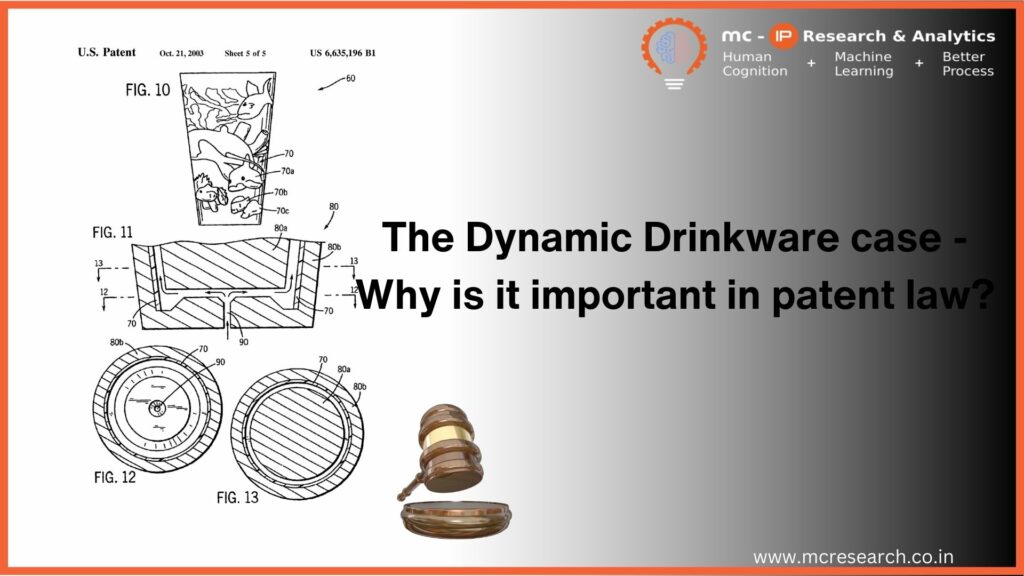Background of the case - Dynamic Drinkware, LLC v. National Graphics, Inc.
National Graphics established in 1976, was the originator of lithographic lenticular imaging. The company designed the first commercially viable lenticular lens, which is now an industry standard. National Graphics owns patent US6635196B1, which is related to manufacturing molded plastic articles bearing a “lenticular” image. Dynamic Drinkware, as a third party filed a petition stating that US patent US7153555B2 anticipated this patent, to which the United States Patent and Trademark Office (PTO) agreed to review the patent held by National Graphics.
Details of both Patents are given below
|
Company |
National Graphics, Inc |
Mark A Raymond |
|
Patent Number |
||
|
Title |
Molded articles having a surface bearing a lenticular image |
Plastic objects including lenticular lens sheets |
|
Priority [RS1] Date |
2000-11-22 |
2000-05-05 |
|
Publication Date |
2003-10-21 |
Dynamic Drinkware argued that four of those claims of US6693196B1 (1, 8, 12, and 14) are not actually new or inventive because they have already been described in Raymond’s patent (US Patent 7,153,555), challenging the validity of the ‘196 patent. The United States Patent and Trademark Office Patent Trial and Appeal Board (Board)concluded that Dynamic Drinkware failed to prove by the strength of the evidence that claims were anticipated under § 102(e)(2) by Raymond. Later, Dynamic Drinkware appealed this decision to a higher court with jurisdiction over patent disputes. Dynamic Drinkware argues that the Board erred in shifting the burden to Dynamic Drinkware to prove that the Raymond patent (‘555) was entitled to the filing date of its provisional application. According to Dynamic Drinkware, Raymond’s presumed effective filing date is February 15, 2000, i.e. the filing date of its provisional application, so it’s a presumptively valid prior art. Dynamic Drinkware explains that Raymond patent (‘555) was thus prior art to the ‘196 patent under § 102(e) as of its provisional date. National Graphics argues, supporting the Board decision that Dynamic Drinkware should take the burden of proving that the provisional application of Raymond provided enough support for the claims in the Raymond patent. This is because priority claims, which establish the effective filing date of a patent, are not examined by the PTO and therefore do not automatically provide adequate written description support in the provisional application. In other words, Dynamic Drinkware needs to prove that the provisional application of Raymond includes enough details and information to support the claims made in the Raymond patent (‘555) further supported by the Board. The court further states that there are two types of burdens of proof – a burden of persuasion and a burden of production. The burden of persuasion is the ultimate burden of proving something to a certain degree of certainty, while the burden of production is the responsibility of producing evidence to support a claim. In an inter partes review (a legal process for challenging a patent), the burden of persuasion is on Dynamic Drinkware to prove that the patent is invalid, and this burden never shifts to the patent owner. The burden of production, on the other hand, is a shifting burden that depends on where the issue arises in the trial process. It involves producing additional evidence or presenting persuasive arguments based on new or existing evidence. Dynamic Drinkware satisfied that burden by arguing that Raymond patent (‘555) anticipated the asserted claims of the ‘196 patent under § 102(e)(2) and burden of production then shifted to National Graphics to produce evidence that either Raymond does not actually anticipate and Raymond patent (‘555) is not prior art because the asserted claims in the ‘196 patent are entitled to the benefit of a filing date prior to the filing date of Raymond. National Graphics produced evidence that the invention claimed in the ‘196 patent was reduced to practice prior to the filing date of Raymond, and thus contended that the asserted claims were entitled to a date of invention prior to that of the Raymond patent (‘555). which again shifted the burden to Dynamic Drinkware to prove that the invention was not actually reduced to practice as argued. Dynamic Drinkware failed to prove that Raymond’s effective date was earlier than the date that the invention claimed in the ‘196 patent was reduced to practice. Dynamic Drinkware argues that it provided sufficient evidence to prove that the Raymond provisional application provided written description support for the claims of the Raymond prior art patent. To prove this, Dynamic Drinkware compared the claims made in the ‘196 patent to the information provided in the Raymond provisional application. Dynamic Drinkware then created a chart showing how the Raymond provisional application anticipates (or supports) claim 1 of the ‘196 patent. Dynamic Drinkware believes that by combining these two charts, it is clear that the Raymond provisional application provides enough information to support the claims made in the Raymond prior art patent (‘555). National Graphics argued that Dynamic Drinkware did not provide enough evidence to support its claim, and even if they did, there is still enough evidence to support the Board’s decision. The Board’s finding that Dynamic Drinkware failed to prove that the Raymond patent (‘555) was entitled to the filing date of its provisional application is supported by substantial evidence. Dynamic Drinkware failed to compare the claims of the Raymond patent to the disclosure in the Raymond provisional application. A reference patent is only entitled to claim the benefit of the filing date of its provisional application if the disclosure of the provisional application provides support for the claims in the reference patent in compliance with § 112. The Board determined that Dynamic Drinkware was unable to prove, with a greater weight of evidence, that claims 1 and 12 of the ‘196 patent were anticipated by the Raymond patent (‘555) under § 102(e). This case highlights the importance of meeting the burden of proof in patent cases, and providing evidence to support claims made. Also, the importance of providing sufficient evidence to support a claim, especially in the context of patents MC Research Private Limited can help clients involved in patent-related legal cases by conducting thorough patent searches to identify relevant prior art that may be used to challenge the validity of a patent or to assess the patentability of a new invention. Our patent researchers are thoroughly trained by EP and US attorneys and we always take precedence to Dynamic Drinkware vs. National Graphics case study while handling provisional applications when working on patent searches. MCRPL has also been helping clients evaluate the risks of infringing on existing patents by conducting patent infringement searches. By providing clients with comprehensive information and analysis related to patents, patent search services can help clients make informed decisions and avoid potential legal issues.Argument and discussion - Dynamic Drinkware, LLC vs National Graphics, Inc.
Argument number 1 - Shifting burden
Argument number 2 - Comparing claims

The Board’s decision
Conclusion
Lessons Learned from this case
Interested in Dynamic Drinkware case – Why is it important in patent law? 2015 ? Reach out to us.
Contact US
#59/2,Heritage Building, Kaderanahalli,Dr. Puneeth RajkumarRoad, Banashankari 2nd Stage, Bangalore 560070, Karnataka, INDIA
Products
-
MCRANK- Get your relevant patents under 10 minutes with high relevancy
-
MCPAT- Intuitive Platform to slice and dice large set of data, visualize and create actionable intelligence
- ICube Cognitive – Leaving ordinary monitoring behind!
- MCMAPP- Very well curated Claim Charts & EoUs readily available at a click of a button
- MCPAIRS- First full text Indian Patent database
- IPLS- First Legal status data of Indian Patents






